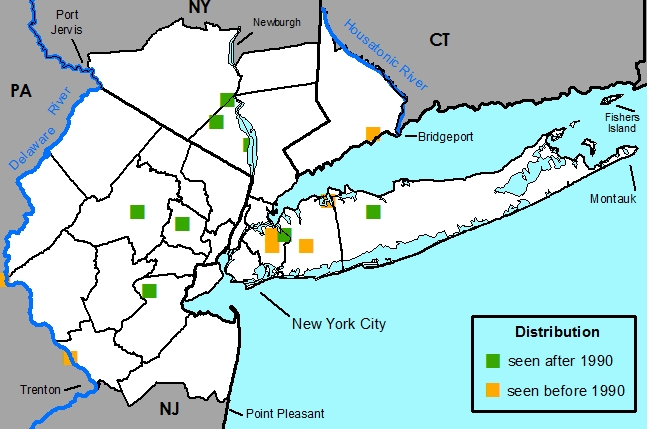Lonicera fragrantissima Lindl. & Paxt. - Fragrant Honeysuckle,Winter Honeysuckle,Sweet Breath of Spring

Common Names
Fragrant Honeysuckle,Winter Honeysuckle,Sweet Breath of SpringField Identification
Large semi-evergreen shrub with arching branches and with opposite, toothless leaves; fragrant white-yellow tubular flowers in late winter to early spring followed by red berries.Other uses
(Flint, 1983) (Rehder, 1940)Ornamental shrub used in landscaping situations; introduced into cultivation about 1845; hardy to USDA Zone 5(b); retains foliage quality in dry soil better than most Lonicera species.
Poisonous properties
Disclaimer: The information provided here is for reference and historical use. If you believe you have been poisoned, please contact the Poison Control Office near you (look for the number in the front of the phone book).
Although the berries of some species are known to be edible; generally, ingestion of the fruit causes mild to moderate nausea, vomiting, and diarrhea; death is unlikely.
Nomenclature
Lonicera fragrantissima Lindl. & Paxt., Paxton's Flow. Gard. 3: 75, fig. 268. 1852.Lonicera caprifolioides K. Koch, in Ind. Sem. Hort. Berol. 1871(app.) 3. 1871.
Lonicera niaguarilli hort. ex K. Koch., in Ind. Sem. Hort. Berol. 1871(app.) 3. 1871.
Lonicera odoratissima hort. ex Dippel, Handb. Laubh. 1: 226. 1889.
Caprifolium fragrantissimum Kuntze, Rev. Gen. Pl. 1: 274. 1891.
Lonicera volgarensis hort. ex [Nicholson in] Kew Handlist Trees Shrubs 2: 15. 1896.
Chamaecerasus niaguarilli hort. ex [Nicholson in] Kew Handlist Trees Shrubs 2: 15. 1896.
Caprifolium niaguarilli hort. ex [Nicholson in] Kew Handlist Trees Shrubs 2: 15. 1896.
Xylosteum fragrantissimum Small, Fl. Southeast. U.S. ed. 2, 1368. 1913.
TYPE: unknown
Description
HABIT Perennial, semi-evergreen, phanerophytic, shrub, monoclinous, 1-4 m tall.STEMS Main stems ascending or erect, round. Bark gray, furrowed to fibrous, exfoliating on older stems. Branches ascending or horizontal to arching. Current year twigs tan colored and smooth; older twigs gray and fibrous, terete, 1-5 mm in diam., glabrous. Pith white, round, continuous, nodal diaphragm absent. Sap translucent. For a detailed analysis of the root anatomy see Gasson, 1979.
BUDS Terminal and axillary present, scattered along stem; terminal bud ovoid, pointed; axillary buds 1 per axil, ovoid, pointed. Bud scales light brown, imbricate, glabrous. Bud scale scars not encircling the stem. Leaf scars thinly crescent-shaped. Vascular bundle scars 3.
LEAVESOpposite, simple, spaced somewhat evenly along and divergent from stem. Stipules absent. Leaves petiolate, petiole furrowed, 0.25-0.4 cm long, with long and unbranched erect or spreading hairs, sparsely distributed throughout; not glabrescent, often tinged purple. Leaf blades: abaxial surface pale bluish-green, adaxial surface green, elliptic or ovate or obovate or widely elliptic or widely ovate, bilaterally symmetric, 2.5-7 cm long, 1.5-4.5 cm wide, base cuneate or obtuse, margin entire or ciliate, apex acute or obtuse, mucronate. Abaxial surface glabrous or with long and unbranched erect or spreading white hairs, sparsely distributed along midveins. Adaxial surface glabrous.
INFLORESCENCESPrecocious or coetaneous, formed on last season's growth, bisexual, axillary, 2-flowered cyme. Peduncle 0.4-0.6 cm long, glabrous. Rachis absent, flowers sessile at apex of peduncle. Bracts petiolate, light green, often tinged purple, linear triangular, 5-7 mm long, 1 mm wide, margin entire or ciliate, apex acute, glabrous (sometimes slightly pubescent?). Bracteoles 0.
FLOWERSWith sepals and petals readily distinguishable from one another, 5-merous, 2 flowers per inflorescence, highly fragrant. Calyx actinomorphic, of fused sepals, persistent, green tinged with purple. Sepal lobes 5, triangular, 1-1.5 mm long, 0.5-1 mm wide, margin entire, apex obtuse, glabrous. Corolla zygomorphic, infundibuliform, of fused petals, deciduous, abaxial and adaxial surfaces white to light yellow or yellow, often tinged purple, 12-15 mm long, gibbous at base. Petal lobes 5, margin entire, apex obtuse, surfaces glabrous. Gynoecium syncarpous. Locules 2-3. Stigmas 1, capitate. Styles 1, glabrous. Ovary inferior, glabrous. Placentation axile. Androecium epipetalous, haplostemous, inserted near the top of the corolla tube. Stamens 5. Anthers opening along the long axis, yellow, glabrous. Filaments straight, glabrous. For a detailed analysis of the flower micro-anatomy and vascularization see Wilkinson, 1948.
FRUITS Bibacca, red, 6-8 mm in diameter, oblong, glabrous.
Habitat
Found in mesic disturbed sites such as thickets, old fields, and rocky outcrops.Distribution
Indigenous to eastern China, escaping from cultivation and naturalizing in the eastern United States and Utah.
United States -- AL, GA, KY, LA, MD, NC, NY, OH, PA, SC, TN, UT, VA
New York Metropolitan Region -- Nonnative, naturalizing in isolated spots in the metropolitan area.
Rarity Status
Heritage global rank -- G5Species Biology
Probably: Mellitophily -- Andrena?, Bombus?, Halictus?, Megachile?, Osmia?
Mycophily -- Mesogramma?
Phalaenophily? -- Hemaris?
Ornithophily? -- Trochilus? (Hummingbird)
Endozoochory via avian frugivores: Turdus migratorius (Robin), Catharus minima (Gray-cheeked Trush), Catharus ustulatus (Swainson's Thrush), Dumetella carolinensis (Gray Catbird), Bombycilla cedorum (Cedar Waxwing), Cardinalis cardinalis (Cardinal), Carpodacus purpureus (Purple Finch), Carduelis tristis (Goldfinch), Zonotrichia albicollis (White-throated Sparrow), Mimus polyglottus (Mockingbird), Dendroica coronata?(Yellow-rumped Warbler), Toxosoma rufum? (Brown Thrasher), Cyanociita cristata? (Blue Jay)
Natural germination is believed to occur in the spring following autumn/winter dispersal. Germination is epigeous.
Seeds are believed to have morphophysiological dormancy. Following an eight-week warm stratification period seeds germinated at 64-73%; 12 weeks of cold stratification did not break dormancy. Hidayati, 2000
While definite information for the optimum storage of Lonicera seeds is lacking; generally, seed stored in a sealed container at 41 degrees F should remain viable for at least one year.